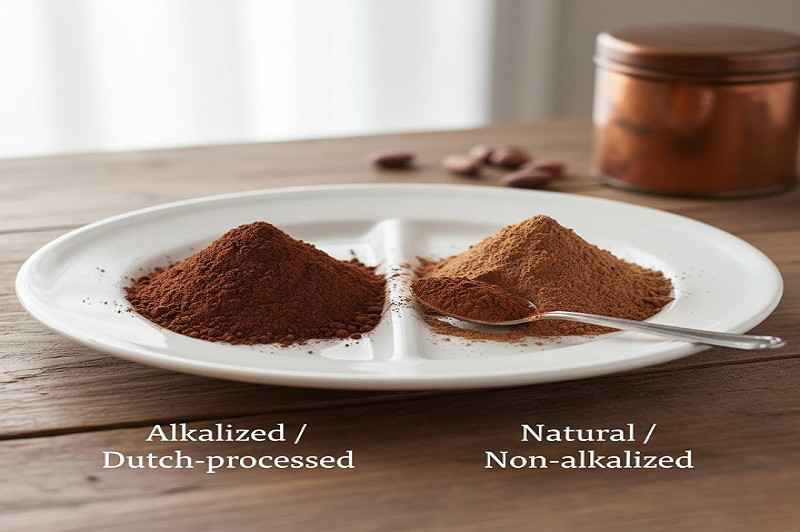Chocolate recipes can taste completely different depending on the cocoa powder you use. Some bakers swear by alkalized cocoa powder for its smooth flavor and deep color, while others prefer the tangy, bold taste of non alkalized cocoa powder. You can get the ideal texture, color, and chocolate strength in every recipe by understanding the differences between alkalized vs non alkalized cocoa powder. In this guide, we’ll explain how each type works and highlight the benefits of using alkalized cocoa powder.
Understanding the Cocoa Alkalization Process
Treating cocoa powder with an alkaline substance like potassium carbonate is part of the alkalization process. The cocoa's pH level goes, from being acidic to being neutral, or slightly alkaline. By doing this, the cocoa becomes less bitter, and more soluble which can influence the way it reacts in recipes.
Because it has a direct impact on taste, color and texture, this process is crucial when comparing alkalized vs non alkalized cocoa powder. Due to its deeper color and smoother taste, alkalized cocoa powder is frequently used in chocolate drinks, and some baked goods.
Key Differences Between Alkalized and Non Alkalized Cocoa Powder
Flavor Differences
Alkalized and non alkalized cocoa powders taste very different from one another. The taste of cocoa powder that hasn't been alkalized is stronger, and more bitter. Adding this to recipes can give them a rich, slightly sour chocolate taste.
Alkalized cocoa powder, on the other hand, is not as strong and bitter. It's great for recipes where you want the chocolate to taste rich but not sharp because of its smooth flavor. Knowing the difference between these types of cocoa can help you pick the best one for baking brownies, cookies, or cakes.
Color and Appearance
Color is another factor to consider. Non alkalized cocoa powder is lighter and has a reddish-brown hue. Alkalized cocoa powder is usually a deep brown color, but it can be almost black.
This difference can influence the appearance of your baked goods. If you want a rich, dark chocolate cake, alkalized cocoa powder is usually the preferred choice. For lighter chocolate recipes, non alkalized cocoa works well.
Baking Considerations
Alkalized vs non alkalized cocoa powder can change the outcome of your baked goods. Because non-alkalized cocoa powder is acidic, it works with baking soda to make cooked goods rise. It can improve the texture, and volume of food when used in recipes that call for baking soda.
The reaction between baking soda and alkalized cocoa powder is different because they are neutral. A lot of the time, baking powder or other leavening ingredients are used in recipes that use alkalized cocoa. If you pick the right cocoa, your cookies, brownies, and cakes will rise correctly and have the right texture.
Uses in Recipes
Both types of cocoa powder have their place in the kitchen. Non alkalized cocoa powder works well in recipes where a strong chocolate flavor, and a lighter color are desired. Homemade hot cocoa, chocolate muffins, and standard chocolate cakes all use it a lot.
Alkalized cocoa powder benefits recipes that need a smoother flavor, and darker color. It works great for chocolate ganache, dark chocolate cookies, and rich cakes. Because it is easy to dissolve, it is also a good choice for frostings and chocolate drinks.
Alkalized Cocoa vs Natural Cocoa in Cooking
When comparing alkalized cocoa vs natural cocoa, the key differences are acidity and flavor intensity. Natural cocoa has a pronounced tang and works well in recipes needing that acidic reaction. Alkalized cocoa provides a more mellow taste and deeper color.
Choosing between them depends on the result you want. Non-alkalized cocoa is best if your recipe needs baking soda to work because it is acidic. Most of the time, Premium Alkalized Cocoa Powder is chosen for sweets, or chocolate flavors that are smoother.
Alkalized Cocoa Powder Benefits
There are several benefits to using alkalized powder in recipes:
- Milder Flavor: Alkalized cocoa has a smoother taste, which makes baked goods less bitter.
- Darker Color: It gives chocolate desserts a rich, deep brown appearance.
- Better Solubility: It mixes easily into liquids, making it suitable for drinks and frostings.
A lot of bakers, and chocolate enthusiasts like alkalized cocoa powder because it has these benefits.
How to Choose the Right Cocoa Powder?
When selecting cocoa powder, consider the recipe requirements:
- Alkalized powder is often the best choice when you want your cookies, brownies, or cakes to look and taste like rich chocolate.
- For recipes needing a reaction with baking soda or a slightly acidic taste, Rainforest Dark Non-Alkalized Cocoa Powder works better.
- Keep in mind the visual and flavor outcome; alkalized cocoa will provide smoother taste and darker shades, while natural cocoa gives stronger chocolate flavor, and reddish tones.
Understanding the cocoa alkalization process and its effect on cocoa powder can make a noticeable difference in your baking results.
Making the Right Choice for Your Chocolate Recipes
When it comes to choosing between alkalized vs non alkalized cocoa powder which one fits your recipe best? For recipes that require baking soda to rise properly, non alkalized cocoa has a more acidic, sharp flavor. Alkalized cocoa powder, on the other hand, has a smoother taste, a deeper color, and is easy to mix. This makes it a favorite for making rich chocolate drinks and sweets.
Wondering which cocoa will make your cake or brownies look and taste just right? It can make a huge difference to pay attention to the taste, color, and how it bakes. Try experimenting with both kinds and see how your favorite recipes can be improved by using both varieties.
Don’t wait—match the cocoa to your recipe and bring rich chocolate flavor to every bite.


